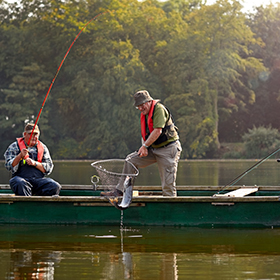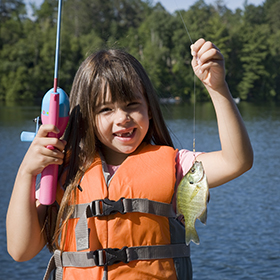Learn how aquatic resources are managed and conserved based on information collected about fish age, growth rates, and influencing factors. Fisheries research improves many waterways, including local fishing spots.
Fisheries biologists and managers of other aquatic ecosystems periodically gather data from fish populations that can be applied to conservation of local fishing spots. By using a variety of sampling methods they can monitor, for example, how well fish are reproducing in the wild. They also can estimate fish growth rates by examining different hard body structures, depending on the species.
Methods of Fisheries Research on Fish Populations
The most reliable aging structure for freshwater drum and walleye, popular in many aquatic ecosystems, is a set of circular bones in the back of the head called otoliths. Unfortunately, to access this growth recording “black box,” if you will, a few of these fish must be headed for the big frying pan in the sky. Catfish age is found by the removal of one pectoral spine, which soon heals. And then there are the luckiest types of fish such as largemouth bass, which can be aged by collecting a few scales from a specific area.
Fisheries research technicians then prepare these samples. The otoliths and spines are cut into thin layers and then mounted on microscope slides, along with the scales, which are already thin enough. They then use high powered microscopes, paired with precise measuring computer software to examine and measure the patterns.
Similar to counting the growth rings of a tree, there will be rings on these growth structures. When the rings are widely spaced, the fish is growing quickly such as when the water is warm and fish are active. When rings are tight, that means growth of the fish is slow, such as during winter. Thus, we can begin to estimate the years that fish has experienced.
Other Factors that Affect Fish Growth Rate
Studies of different aquatic ecosystems have shown that although growth rates are highly correlated to temperature and latitude, (bass grow faster in the southern waters due to longer days and longer warm periods) this is not an exact science. Stresses such as spawning activity can slow growth. And there are species that may spawn more than once a year.
Aging fish populations takes special scientific equipment and lots of practice. But with a large enough sample size, information about growth rates and the influencing factors can be used to manage and conserve aquatic resources like your local fishing spots and maximize the fishing opportunities for everyone.
Want to learn more about conservation of aquatic ecosystems? Also don’t forget that when you buy a fishing license you help conserve our waterways for future generations.
Methods of Fisheries Research on Fish Populations
The most reliable aging structure for freshwater drum and walleye, popular in many aquatic ecosystems, is a set of circular bones in the back of the head called otoliths. Unfortunately, to access this growth recording “black box,” if you will, a few of these fish must be headed for the big frying pan in the sky. Catfish age is found by the removal of one pectoral spine, which soon heals. And then there are the luckiest types of fish such as largemouth bass, which can be aged by collecting a few scales from a specific area.
Fisheries research technicians then prepare these samples. The otoliths and spines are cut into thin layers and then mounted on microscope slides, along with the scales, which are already thin enough. They then use high powered microscopes, paired with precise measuring computer software to examine and measure the patterns.
Similar to counting the growth rings of a tree, there will be rings on these growth structures. When the rings are widely spaced, the fish is growing quickly such as when the water is warm and fish are active. When rings are tight, that means growth of the fish is slow, such as during winter. Thus, we can begin to estimate the years that fish has experienced.
Other Factors that Affect Fish Growth Rate
Studies of different aquatic ecosystems have shown that although growth rates are highly correlated to temperature and latitude, (bass grow faster in the southern waters due to longer days and longer warm periods) this is not an exact science. Stresses such as spawning activity can slow growth. And there are species that may spawn more than once a year.
Aging fish populations takes special scientific equipment and lots of practice. But with a large enough sample size, information about growth rates and the influencing factors can be used to manage and conserve aquatic resources like your local fishing spots and maximize the fishing opportunities for everyone.
Want to learn more about conservation of aquatic ecosystems? Also don’t forget that when you buy a fishing license you help conserve our waterways for future generations.









